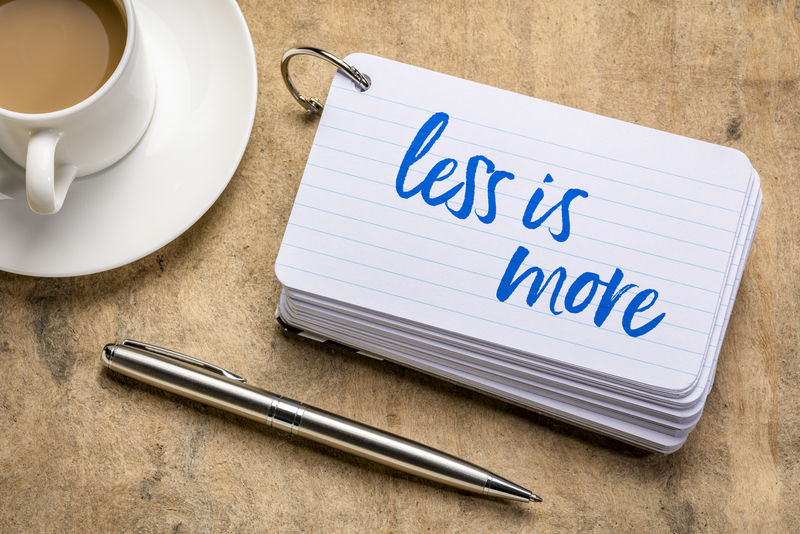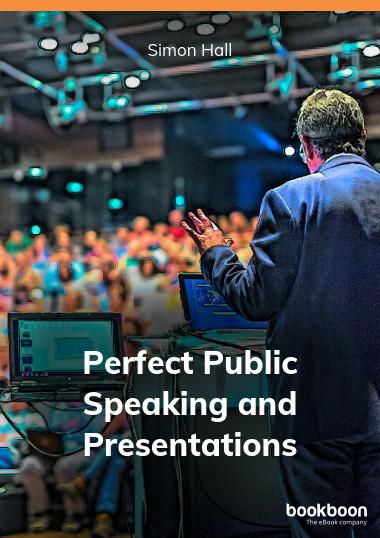3 Ways to Work Less But Achieve More

Whether it’s a report, presentation, pitch deck, or any kind of communication, you can make more impact with less work. Save time, save effort, maximise success. What’s not to like about that?! The secret is in the old saying, Less is More. And this is how it’s done, with words and pictures.
By Simon Hall
Less is More With Words
Here’s one of the most common fails in the world of words. What happens when you’ve got a new company, product or service to promote?
A mass of work has gone into it. You’re really excited it’s finally good to go, and you want to tell the world all about it.
So you talk too much. And what happens?
People switch off. Stop listening. Mentally move on. Because no one likes a blabbermouth.
How to avoid that? Make use of less is more. The elegant art of less words for more impact.
Less is More In One Line
The first step you need to take is to decide on your key message. Sum up the core of what you want to say in one line, and one line only.
Then make sure to stick to it, and it alone. Know exactly what you want to say and stop, by summing it up in a handful of words.
For example, with my company, Creative Warehouse, we provide all the communications support a business could need. From a clear and compelling core message, to writing work, websites, design, pitching and presenting, media coverage and public relations. You name it, we do it.
So our key message is, All Your Communication Problems Solved With Style.
Don’t forget your values and character, either. We make sure all our work is done to the very highest standards and we’re a pleasure to work with, or try to be, anyway. Which is where the With Style part comes in.
Playing on positive emotions is an important part of a key message. We’re human, after all. We run on feelings sure as a bunnies run on carrots.
If ever I talk about the company, that key message is what holds my words together. Keeping it sharp and simple, using less is more, and not forgetting the feeling thing, speaking with pride and passion. And I’m happy to say we’re doing well on it.
Less Is More Case Studies
A great example is Nike, and their Just Do It slogan. All their communications gathered under that brilliant banner.
From the first TV advert, with 80 year old Walt Stack running across San Francisco, to modern day sportspeople, the message is all about just doing it.
(With help from Nike, and their range of kit, of course.)
Still not convinced you can make more impact with less words? Don’t just listen to me. Or Nike, for that matter. Here’s the gold standard in the art, a very famous case study courtesy of a certain Abe.
Abraham Lincoln credit -Izanbar / Dreamstime
Abraham Lincoln’s Gettysburg Address has gone down in history as one of the finest examples of speechmaking the world has ever witnessed.
But do you know how long it was? It must have been quite an oration you’re thinking, to make such an impact. A real epic of a speech.
No. Not a bit of it. Nothing like it. The Gettysburg Address was only…
Wait for it… wait for it…
272 words.
Yes, only 272. It probably took Lincoln less than two minutes to deliver.
But wow, what an impact. Because with equality, freedom and democracy as his key message, Lincoln knew exactly what he wanted to say. And he said it with pride and passion, and how.
Less is more. It works with words every time.
Less is More, Soundbites Style
Another way to make more impact with less work is to choose your words carefully and cunningly.
Carefully to ensure it’s absolutely crystal clear what you’re saying. Cunningly to help them lodge in the public mind.
That’s where crafting soundbites come in. Which is just a posh way of saying finding some form of phrasing that plants your words in the memory.
So, how to achieve that?
Soundbites By Threes
You can build soundbites effectively using the rhythm of threes, which is always attractive to the ear.
Lincoln himself was a fan of this trick, and wielded it to great effect at the end of the Gettysburg Address:
- Government of the people, by the people, for the people, shall not perish from the earth.
The UK government used threes to powerful effect during the dreadful Covid crisis, drumming in the importance of obeying the lockdown:
- Stay home, protect the NHS, save lives.
The beat of threes is my favourite way of constructing soundbites. But there are others.
Soundbites By Counterpoint
Counterpoint works a treat in soundbites, the trick of setting up one concept and then switching to its opposite. The incredible and inspirational Malala Yousafzai used this technique when she cast a spell over the United Nations Youth Assembly with her speech on the importance of education.
She had narrowly escaped assassination by the Taliban in Pakistan for having the cheek to stand up for the rights of girls and young women to an education:
- We realise the importance of light when we see darkness. We realise the importance of our voice when we are silenced. We realised the importance of pens and books when we saw the guns.
I still can’t read that without a shudder running up my back, and drumming on the table in appreciation. No wonder so many people from around the world rallied in her support.
Soundbites By Metaphors
Another fine way of sprinkling in some super soundbites (see what I did there?!) is metaphors. This way you can really have fun and be creative. A couple of examples:
A life sciences company I work with here in Cambridge has an amazing product that can help scientists understand how medicines work at the smallest level. So in that case we talk about eyes amongst the atoms.
Metaphors can feature whatever your story might be. When I’m in a whimsical mood, my LinkedIn profile talks of me as a Wandering message magician, making all your communication problems disappear.
See how all these soundbites sparkle with the sheen of less being more? They’re brief, but highly effective. Yet again, it’s an example of how you can use less words for more impact.
But one word of warning. Don’t be too contrived with soundbites. That can make them sound naff. The best ones flow easily into your communications.
And don’t overuse them, either. One per talk, paper, or report is usually about right.
Once again, as I may have mentioned…
Less is more.
Less is More With Slides, Images and Graphics
Most of us parents have delighted (or not) in our children’s pictures decorating our desks at some point in life.

Azyd Azyd Aqsha / Dreamstime
(What they lack in spelling, they often make up for in colour and detail!)
But how much do you think you’d get for such a picture at an auction?
Yep, I don’t think you’d be making a great deal and heading off for an early retirement either.
However, contrast such pictures with the very different style of the iconic abstract painter, Mark Rothko.

Klaus Hoffmann / Dreamstime
How much do his works go for? Any thoughts?
Tens, if not hundreds of millions of dollars is the answer. How about that for an example of less being more?
The trick works with slides, too.
Take an example of how I could talk about what Creative Warehouse does:

That’s a reasonable summary. From website design and build, to any form of writing work, high end videos, media coverage and public relations. In other words all your communication needs.
But what a busy and unattractive slide it is. A little like a kid’s picture, you might think. Attempting to say too much, trying too hard, which is a trait that often reeks of amateurism.
So maybe there’s a better way. With minimal use of words, and an appealing image:

How much more elegant, effective and memorable is that?
Less Is More Love In
Finally, if you should ever doubt that less is more, here’s the poster child, example number one, gold medal winning, slam dunk of a hell of an amazing success story, much of it based on less is more.
This business has cornered about 90% of its market. It’s the unchallenged, no one else even comes close, world number champion, absolute go to in its field.
It’s so successful its name has even become a verb. And when that happens, you really know you’re made.
You probably use it several times a day, without even noticing how much of its impact is based on less being more. Because back in the day when these things were developing, its rivals were clunky, and complex, took thought and effort, and were just a general pain in the backside to work with.
Not this bunch. Here simplicity and less is more were critical to its storming success.
So, what is it? What is this magical marvel?
Before I reveal what it is, have a think, and a guess.
Any ideas?
The answer is just a click away, if you’ll excuse the tease. With all due fanfare, and not forgetting to marvel at the brilliant simplicity of the less is more approach, it’s here.
A Last Word, Less is More Style
Mostly in life, if something sounds too good to be true then it generally is.
Not with less is more.
I’ve never known it fail to be effective. Whatever you’re struggling with in the communication world, go back to basics, cut it down to essentials, focus on the very heart of what you’re trying to achieve, and less is more will guide you through.
If you’re interested in reading further, it’s one of the main themes in my ebook, Accelerating Your Business Through Communication, which takes you on a complete journey through business messaging.
I also regularly post on LinkedIn with communication tips. You’d be very welcome to join my network if you’d like to send me a contact request. I also write weekly blogs on the Creative Warehouse website.
All in a less is more style, of course.
Try the less is more trick with a communication problem you might have, see how you get on, and if it helps in cracking the case please let me know in the comments.
You only have to be brief. After all, as we’ve well and truly nailed by now…
Less is more!
About The Author
Simon Hall runs his own complete communications agency, Creative Warehouse, and teaches communication skills at the University of Cambridge. He’s also a journalist and writer with a series of novels and non fiction business communication books published, and was a BBC TV News Correspondent for 20 years.

